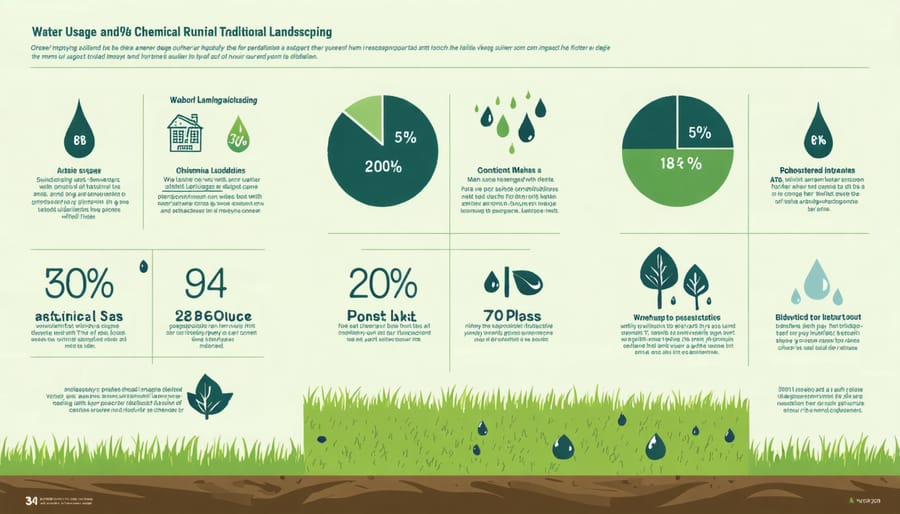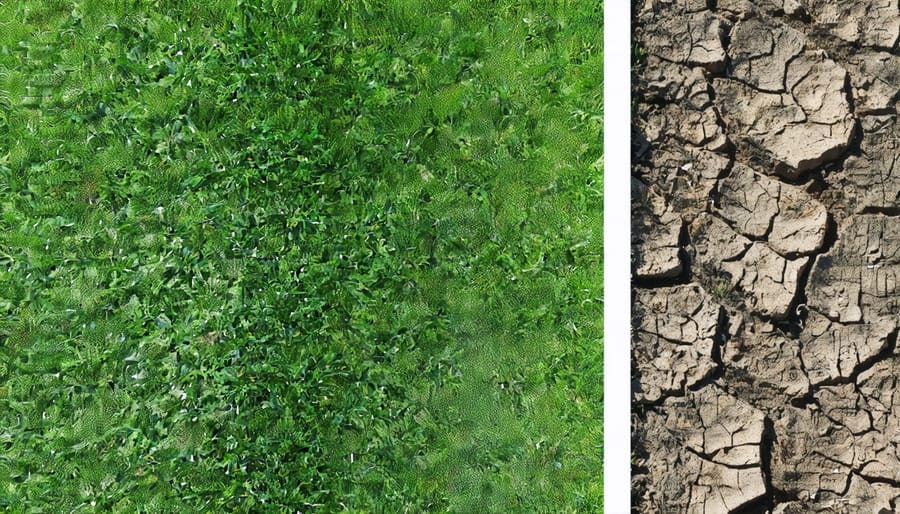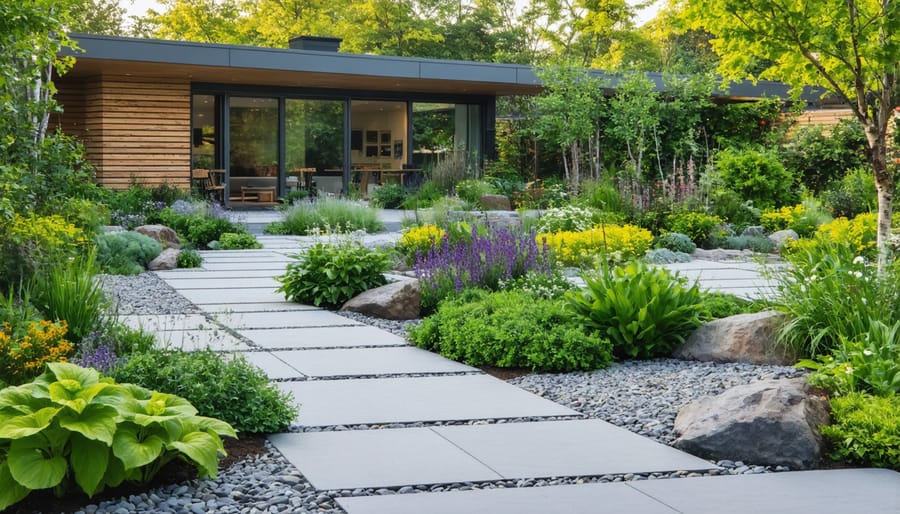Transform your thirsty, high-maintenance landscape into an eco-friendly oasis by replacing water-hungry lawns with native plants that thrive naturally in your climate. Traditional landscaping practices – from excessive water usage and chemical fertilizers to non-native plant species and resource-intensive maintenance – are taking a toll on both our environment and our wallets. Every year, American households pour billions of gallons of water into unsustainable yards while releasing harmful chemicals into our soil and waterways.
But creating a beautiful outdoor space doesn’t have to come at nature’s expense. By understanding how conventional landscaping practices harm our ecosystems, we can make informed choices to design spaces that work with nature rather than against it. The good news? Sustainable landscaping isn’t just better for the planet – it typically requires less maintenance, reduces water bills, and creates more resilient gardens that flourish year after year.
In this guide, we’ll explore the hidden environmental costs of common landscaping practices and provide practical solutions to transform your outdoor space into a sustainable sanctuary. Whether you’re starting from scratch or gradually transitioning an existing landscape, you’ll discover how small changes can make a big impact on both your property’s ecological footprint and its natural beauty.

The Hidden Environmental Costs of Traditional Landscaping
Water-Hungry Lawns
Those lush, green lawns might look picture-perfect, but they’re actually one of the biggest water guzzlers in residential landscaping. The average American lawn drinks up about 30% of household water consumption – that’s thousands of gallons every year just to keep grass green! In many regions, especially those prone to drought, maintaining these thirsty lawns simply isn’t sustainable.
Think about it: we’re using drinking-quality water to maintain a non-native plant species that often struggles to survive in our local climate. During peak summer months, some homeowners use up to 70% of their water supply just for lawn maintenance. This not only strains local water resources but also leads to higher utility bills and potential water restrictions during dry seasons.
The environmental impact goes beyond water waste. Regular lawn maintenance typically involves gas-powered equipment, chemical fertilizers, and pesticides that can harm local ecosystems. Plus, these traditional lawns offer minimal benefits to local wildlife and pollinators compared to native landscaping alternatives. The good news? There are plenty of beautiful, low-water alternatives that can transform your outdoor space while being kind to the environment.

Chemical Dependencies
Many traditional landscapes rely heavily on chemical solutions for that picture-perfect look, but these quick fixes come with a hefty environmental price tag. Chemical fertilizers might give your lawn that vibrant green color, but they can actually weaken plants over time, making them dependent on continued chemical support. Think of it like caffeine – a quick boost that leaves you needing more.
Pesticides and herbicides pose even bigger concerns. While they effectively eliminate unwanted insects and weeds, they don’t discriminate between harmful and beneficial organisms. These chemicals can destroy essential soil microbes that naturally support plant health and can seep into groundwater, affecting local water quality and aquatic ecosystems.
The impact extends beyond your yard. When it rains, these chemicals wash into storm drains, eventually reaching rivers and lakes. This runoff contributes to algal blooms and can harm fish populations. Plus, chemical residues can affect beneficial insects like bees and butterflies, which are crucial for pollination.
The good news? You can break free from this chemical dependency by embracing natural alternatives like compost, beneficial insects, and native plants that naturally thrive in your local environment.
High-Maintenance Features
While beautiful, certain landscape features can drain both your resources and wallet. Swimming pools require constant maintenance, chemical treatments, and significant energy for heating and filtration systems. Ornamental fountains and water features need regular cleaning, pump maintenance, and continuous power to operate. Elaborate lighting systems, particularly those left on throughout the night, contribute to high electricity bills and light pollution. High-maintenance lawns often demand frequent mowing, watering, and chemical treatments to maintain their manicured appearance. These resource-intensive elements not only increase your monthly expenses but also place unnecessary strain on local water supplies and energy grids. Consider how often you’ll actually use these features before installing them, as their environmental impact often outweighs their aesthetic benefits.
Smart Solutions for Sustainable Outdoor Spaces

Native Plant Selection
Embracing native plants in your landscaping isn’t just a trend – it’s a smart approach to creating a sustainable and thriving outdoor space. These indigenous heroes are perfectly adapted to your local climate, requiring significantly less water, fertilizer, and maintenance than non-native species. By incorporating natural sanctuary design principles with native plants, you’re not just saving resources – you’re creating a haven for local wildlife and pollinators.
Start by researching plants native to your specific region through local extension offices or native plant societies. Consider mixing different heights and textures: ground covers, shrubs, and trees that naturally occur in your area. These plants have evolved to handle local weather patterns and resist regional pests, meaning you’ll spend less time fighting nature and more time enjoying your outdoor space.
Native plants also create a sense of place, connecting your landscape to the broader local ecosystem. Think of butterfly-attracting milkweed in meadow gardens, drought-resistant sage in xeriscaping, or native ferns in shaded areas. The best part? Once established, these plants typically require minimal intervention, saving you time and money while reducing your environmental impact.
Remember to group plants with similar water needs together and consider their mature sizes when planning. This thoughtful approach ensures your native garden remains both beautiful and sustainable for years to come.
Water-Wise Design
Water conservation in landscaping doesn’t mean sacrificing beauty for efficiency. Modern irrigation systems have revolutionized how we maintain our outdoor spaces, offering smart solutions that save both water and money. Consider installing a drip irrigation system, which delivers water directly to plant roots, reducing waste through evaporation and overspray. These systems can be paired with moisture sensors and smart controllers that automatically adjust watering schedules based on weather conditions.
Group your plants according to their water needs, a practice known as hydrozoning. This simple strategy ensures that water-loving plants receive adequate moisture while drought-resistant varieties aren’t overwatered. Native plants are particularly excellent choices as they’re naturally adapted to your local climate and typically require less supplemental watering.
Incorporating rainwater harvesting systems, like rain barrels or underground cisterns, can significantly reduce your reliance on municipal water supplies. These systems can be seamlessly integrated with solar-powered lighting solutions and other eco-friendly features to create a sustainable landscape.
Consider using permeable materials for pathways and patios, allowing rainwater to naturally seep into the ground rather than running off. Adding a layer of organic mulch around plants helps retain soil moisture, suppress weeds, and reduce water needs. These water-wise design choices not only conserve resources but also create resilient, low-maintenance outdoor spaces that thrive in various weather conditions.
Natural Entertainment Areas
Creating a natural entertainment area doesn’t mean sacrificing fun for sustainability. Many traditional gathering spaces rely heavily on resource-intensive materials and high-maintenance features that harm the environment. Instead, consider transforming your outdoor space into an eco-friendly entertainment paradise using sustainable materials and design principles.
Start by incorporating native plants to create natural privacy screens and shade areas, eliminating the need for artificial structures. Use permeable materials like gravel or recycled pavers for seating areas and pathways, allowing rainwater to naturally filter into the ground. Consider building a DIY fire pit using reclaimed stones or bricks, surrounded by comfortable seating made from sustainably sourced wood or recycled materials.
Rather than installing energy-hungry lighting systems, opt for solar-powered lanterns or LED string lights that create ambiance without increasing your carbon footprint. Create conversation nooks using strategically placed boulders and fallen logs, which double as natural seating while providing habitat for beneficial insects and small wildlife.
For dining areas, choose weather-resistant furniture made from sustainable materials like bamboo or recycled plastic. Add charm with potted herbs that serve both as decorative elements and fresh ingredients for outdoor cooking. Remember, the key is to work with nature, not against it, creating spaces that bring people together while preserving the environment.
Sustainable Maintenance Practices
Maintaining your landscape sustainably doesn’t have to be complicated or time-consuming. Start by embracing natural maintenance methods like hand-pulling weeds instead of using chemical herbicides. Mulching with organic materials not only suppresses weeds but also helps retain soil moisture and reduces water consumption.
Consider investing in sustainable outdoor features that require minimal upkeep, such as native plants adapted to your local climate. These plants typically need less water and maintenance than non-native species. When pruning is necessary, compost the green waste rather than sending it to landfills.
Water management is crucial for sustainable maintenance. Install a smart irrigation system that responds to weather conditions and soil moisture levels. Consider collecting rainwater in barrels for use during dry spells. Time your watering for early morning or evening to minimize evaporation.
Instead of gas-powered tools, opt for electric or manual alternatives. Electric leaf blowers and mowers produce fewer emissions, while hand tools like rakes and pruning shears offer precise control with zero environmental impact. Sharpen and maintain your tools regularly to ensure they work efficiently and last longer.
Remember to observe and work with nature rather than against it. Let beneficial insects handle pest control naturally, and create habitats that support local wildlife. These practices not only reduce your environmental footprint but also create a healthier, more resilient outdoor space.
Making the Transition
Assessment and Planning
Before embarking on your sustainable landscaping journey, take time to evaluate your current outdoor space. Start by walking through your yard with a notebook, documenting areas that consume excessive water, require frequent maintenance, or use harmful chemicals. Pay special attention to features like water-hungry lawns, invasive species, and inefficient irrigation systems.
Create a simple map of your yard, marking sunny and shady areas, noting soil types, and identifying natural water flow patterns. This visual guide will help you make informed decisions about plant placement and water management. Also, take photos of your current landscape in different seasons to understand how it changes throughout the year.
Next, develop a transformation plan that breaks down your sustainable makeover into manageable phases. Consider your budget, time constraints, and priorities. Start with quick wins like replacing inefficient sprinklers with drip irrigation or swapping out high-maintenance annuals for native perennials.
Set realistic goals and timelines for larger projects, such as removing portions of lawn or installing rainwater collection systems. Remember to research local regulations and obtain necessary permits before making significant changes. Consider consulting with local garden centers or landscape designers who specialize in sustainable practices for expert guidance.
Keep a flexible mindset as you plan – sustainable landscaping is an evolving process that can be adjusted based on your observations and needs over time. Start small, learn from each change you make, and gradually work toward your vision of a sustainable outdoor space.
Budget-Friendly Changes
Transforming your landscape into an eco-friendly space doesn’t have to break the bank. Start by implementing a simple composting system using kitchen scraps and yard waste – this creates free, nutrient-rich soil for your garden while reducing waste. Replace small sections of your lawn with native plants gradually, which can be done by dividing existing plants or starting from seeds rather than buying mature specimens.
Consider joining local gardening groups or online communities where members often exchange plants and cuttings for free. Many native plant societies also host annual sales where you can get region-appropriate plants at discounted prices. Instead of purchasing new hardscaping materials, look for reclaimed or recycled options through marketplace apps or construction salvage yards.
Water conservation can begin with simple DIY solutions like collecting rainwater in repurposed containers or installing an inexpensive drip irrigation system. Mulch made from fallen leaves or grass clippings costs nothing and helps retain soil moisture while suppressing weeds.
For pest control, attract beneficial insects by planting low-cost companion flowers like marigolds or nasturtiums. Create natural borders using fallen branches and stones found on your property instead of buying commercial edging materials. Remember, sustainable landscaping is about working with nature, not against it – and nature often provides the most cost-effective solutions.
As we’ve explored throughout this article, transforming unsustainable landscaping practices into eco-friendly alternatives isn’t just good for the environment – it’s a smart investment in your property’s future. By making thoughtful changes to your outdoor space, you’re not only reducing water waste and maintenance costs but also creating a more resilient and beautiful landscape that can thrive for years to come.
Remember, sustainable landscaping doesn’t mean sacrificing the beauty or functionality of your outdoor space. In fact, it often enhances both while providing additional benefits like increased property value, lower utility bills, and reduced maintenance time. Native plants will attract local wildlife, creating a vibrant ecosystem right in your backyard, while smart irrigation systems and proper soil management will ensure your garden stays healthy with minimal intervention.
The journey to a more sustainable landscape doesn’t have to happen overnight. Start with small changes – perhaps replacing a portion of your lawn with native plants or installing a rain barrel. As you see the positive impacts of these changes, you’ll likely feel inspired to do more. Every step you take toward sustainability helps create a healthier environment for future generations.
Take action today by assessing your current landscaping practices and identifying areas where you can make improvements. Your future self – and the planet – will thank you for it.
